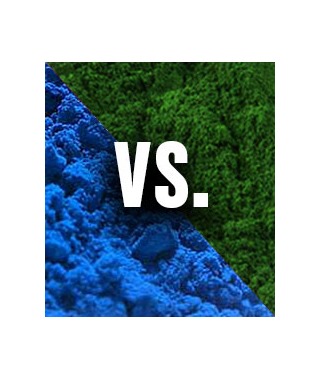Unicorn Frappuccinos? Mermaid toast? Blue lagoon smoothies? Mystical named foods enhanced with natural colors is a current food trend that is taking over many people’s Instagram newsfeeds. The magical ingredient that’s causing all the craze? “Blue” spirulina.
How does blue spirulina differ from traditional spirulina?
Blue spirulina is derived from a blue-green algae, Arthrospira platensis; this algae is more commonly known as spirulina. So where does the blue color come from? The word phycocyanin comes from the Greek phyco (algae), and cyanin (blue-green). Phycocyanin is a pigment that gives spirulina (which is a deep green) a slightly bluish hue. To make blue spirulina, the water soluble antioxidant phycocyanin is extracted from the spirulina and then sold as a blue powder. Phycocyanin is only found in spirulina and some other species of blue-green algae and is one of the key differences between spirulina and other green foods like chlorella, wheat grass and barley. But besides just providing a beautiful blue color, phycocyanin is a powerful antioxidant.
Traditional Spirulina Health Facts
While phycocyanin is a powerful antioxidant that provides many benefits, it’s the singular nutrient found in blue spirulina. Traditional spirulina, like Hawaiian Spirulina® from Nutrex Hawaii, contains high levels of phycocyanin, plus a variety of other essential nutrients. One 3 gram serving of Hawaiian Spirulina provides 2 grams of protein and is a great source of vitamins A, K1 & K2, B12, iron, and manganese. It also contains powerful antioxidants (1, 2) and phytonutrients such as carotenoids, GLA, and superoxide dismutase (SOD).
It’s widely known that nutrients are absorbed best when combined synergistically together (e.g. eating an orange vs. taking a vitamin c supplement) and the same rule applies when it comes to spirulina. By consuming spirulina as a whole, all the nutrients can work together to give your body benefits such as supporting brain health(3) , boosting your energy and immune system(4, 5, 6, 7,8) , supporting cellular health, and cardiovascular health.*
So when consumers ask us why Nutrex Hawaii doesn’t make blue spirulina or what the difference is between Hawaiian Spirulina and blue spirulina, we confidently explain that we believe that the combination of all the natural occurring nutrients in spirulina work better together rather than singling out one specific nutrient like phycocyanin to get a blue powder. This philosophy ensures that we continue to bring you some of the highest quality and beneficial spirulina on earth.
*These statements have not been evaluated by the Food and Drug Administration. This product is not intended to diagnose, treat, cure, or prevent any disease.
References
1. Center for Disease Control and Prevention (2010). “Leading Causes of Death.” Centers for Disease Control and Prevention. Retrieved from http://www.cdc.gov/nchs/fastats/leadingcauses-of-death.htm
2. Hayakawa, Y., Hayashi, T., Hayashi, K., Ozawa, T., Niiva, K., Sakuragawa, N. (Jul. 1996). “Heparin cofactor II-dependent antithrombin activity of calcium spirulan.” Blood Coagul Fibrinolysis, 7(5):554-60.
3. Hayakawa, Y., Hayashi, T., Hayashi, K., Ozawa, T., Niiva, K., Sakuragawa, N. (Mar. 1, 1997). “Calcium spirulina as an inducer of tissue-type plasminogen activator in human fetal lung fibroblasts.” Biochim Biophys Acta., 355(3):241-7.
4. Kaji, T., Fujiwara, Y., Hamada, C., Yamamoto, C., Shimada S., Lee JB., Hayashi, T. (Jun. 2002). “Inhibition of cultured bovine aortic endothelial cell proliferation by sodium spirulina, a new sulfated polysaccharide isolated from Spirulina platensis.” Planta Med., 68(6):505-9.
5. Kaji, T., Okabe, M., Shimada, S., Yamamoto, C., Fujiwara, Y., Lee, JB., Hayashi, T. (Mar. 26, 2004). “Sodium spirulan as a potent inhibitor of arterial smooth muscle cell proliferation in vitro.” Life Sci., 74(19):2431-9.
6. Huang, ZX., Mei, XT., Xu, DH., Xu, SB., Lv, JY. (Feb. 2005). “Protective effects of polysaccharide of Spirulina platensis and Sargassum thunbeergii on vascular of alloxan induced diabetic rats.” Zhongguo Zhong Yao Za Zhi, 30(3):211-5.
7. Sato, T., Yamamoto, C., Fujiwara, Y., Kaji, T. (May 2008). “Biological activities of exogenous polysaccharides via controlling endogenous proteoglycan metabolism in vascular endothelial cells.” Yakugaku Zasshi, 128(5):717-23.
8. Majdoub, H., Ben Mansour, M., Chaubet, F., Roudesli, MS., Maaroufi, RM. (Oct 2009). “Anticoagulant activity of a sulfated polysaccharide from the green alga Arthrospira platensis.” Biochim Biophys Acta, 1790(10):1377-81.

